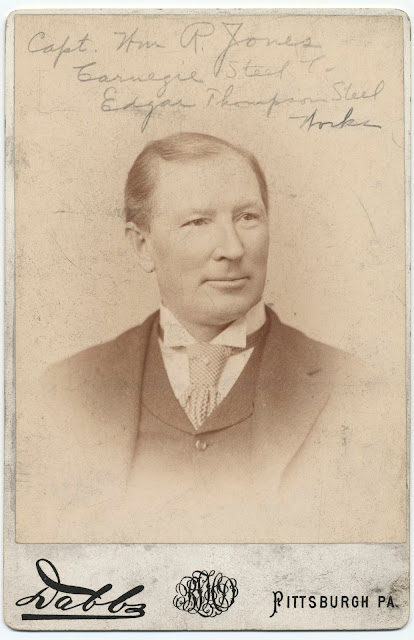Captain Bill Jones, the first and most well-regarded of Andrew Carnegie's steel masters, died a horrific death in a furnace accident at Braddock's Edgar Thomson (ET) works.
 |
| Captain William R. Jones, Courtesy of The Frick Collection/Frick Art Reference Library Archives. |
You'd have to work hard to overestimate the importance of this man to Pittsburgh's industrial history. Had he lived, it's likely that we would be remembering the labor strife leading up to the Battle of Homestead in very different ways.
Born in 1839 in Luzerne County to Welsh immigrants, William R. Jones began working in the steel industry at the age of 10. He spent his early adult years at Cambria Works in Johnstown. Jones took time off for the Civil War, distinguishing himself in service at Fredericksburg and Chancellorsville. Rising from the rank of private, he was forever after in civilian life referred to as Captain Jones.
 |
| Cambria Works, c. 1870s when Captain Bill began innovating steel production there |
When an expected promotion didn't come through at Cambria after dedicating nearly 20 years there, Jones left. He connected with the designer of a new steel plant at Braddock and met its owner, Andrew Carnegie. Always looking for good managers, Carnegie quickly saw that Captain Jones was a keeper. Jones conveniently brought along 200 or so of his best coworkers from Johnstown to the new Edgar Thomson works, and rose to the position of Superintendent.
 |
| Allegheny Conference on Community Development Photographs, Detre Library & Archives, Heinz History Center |
Jones' impact on the steel industry was unsurpassed during the 14 years he spent in Pittsburgh. He engineered hundreds of design innovations and claimed 50 patents. Carnegie biographer J.F. Wall wrote that Jones "had more patents to his credit than any other single individual in the history of steelmaking." His engineering expertise was unparalleled. But so, too, was Jones' ability to communicate with and motivate the men working under him. He organized productivity competitions which both paid dividends to the partners and fostered worker pride. He was a hard-nosed negotiator when doing battle against the Amalgamated labor union, but he consistently advocated for a multicultural work force and a humane eight hour working day for fair pay.
Jones liked what he did on the floors of ET and Homestead, and so turned down an appreciative Carnegie's offer to become a company shareholder. He did, however, manage to negotiate for himself the current salary of the US President. In those days $25,000 a year was impressive, but still a drop in the bucket compared to the earnings of the plants Jones ran.
Many of Jones' innovative designs had worker safety foremost in mind. The guys in the mills worked beside Jones every day. They knew better than anyone how well Jones knew steel, and they bore witness to his loyalty, steady compassion and concern for the community.
After the devastating Johnstown flood of 31 May 1889, Jones shut down ET on his own initiative and took 300 workers to his former hometown, leading the relief effort.
Four months later, Jones was dead.
 |
| Illustration from The Pittsburgh Press, 27 September 1889 |
On the ET floor with his workers on 26 September 1889, Jones took over trying to clear a furnace jam. The furnace gave under pressure. One coworker was incinerated instantly; another died of his injuries a few days later.
Bill Jones suffered severe upper body burns. Thrown backward into the flaming pit by the force of the explosion, he hit his head on the iron edge of a cinder car.
He was taken to the Homeopathic Hospital in Pittsburgh, drifting in and out of consciousness. His burns did not at first seem life-threatening, so the newspapers wrote that Captain Bill would likely recover.
 |
| Pittsburgh Daily Post Friday, 27 September, 1889 |
Even Henry Clay Frick, chairman of the newly consolidated Carnegie Steel Company for only six months, hastened to reassure Andrew Carnegie that Jones seemed to be on the mend:
Henry Clay Frick Business Records, 1862-1987,
AIS.2002.06, Archives & Special Collections, University of Pittsburgh Library System
Captain became very much worse after eight o'clock this morning suffering from concussion of the brain. Have just come from hospital; he is very much better. Saw Doctors Helmeth and McClelland who are quite hopeful.
Hopes were dashed. Captain William R. Jones died the evening of 28 September 1889.
Pittsburgh and Johnstown mourned. Schools and businesses closed, buildings were draped in mourning black, and Andrew Carnegie made the trip from New York for Jones' funeral in Braddock on 2 October.
Grand Army Day had been celebrated a day earlier in Pittsburgh with a 6000 member parade. Usually a magnificent and greatly-anticipated event, it was somber this year. In tribute to Jones, the colors of various regiments were draped with black. A riderless horse carrying the bridle, saddle, boots, spurs, cap and sword of Captain Jones was led through the streets, and was greeted with profound and reverent silence. Jones' heavy cedar casket, closed "due to the heavy facial disfigurements" wrought by the burns he had suffered, was honored with thousands of floral arrangements, the most elaborate ranging in height from 4 to 10 feet.
 |
| Pittsburgh Daily Post Thursday, October 3, 1889 |
Accompanied by ten thousand mourners, Captain William R. Jones was laid to rest in Monongahela Cemetery.
 |
| Captain William R. Jones, Courtesy of The Frick Collection/Frick Art Reference Library Archives. |
It is not a stretch to say that buried with Jones were the hopes of the steelworkers whose welfare he had championed over the years. Three years later, the streets of Homestead would erupt in battle over labor issues that Captain Bill knew plenty about. He would have had things to say about that, but his mighty voice had been forever silenced.
**A version of this article was posted to my Facebook page on 28 September 2017
